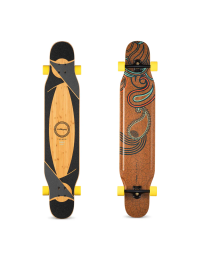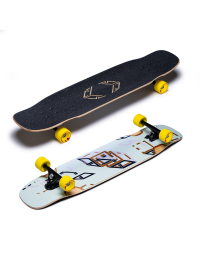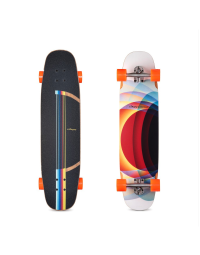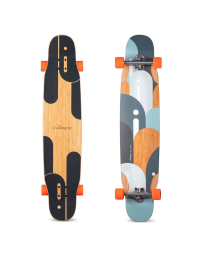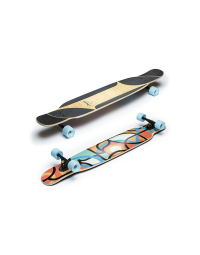Top 5 Tricks to Start Longboard Dancing
Have you ever watched those viral videos where riders glide effortlessly across their boards, weaving in stylish steps as if they’re dancing on air? Have you imagined creating your own unique longboard flow?
This is where it starts. Mastering these five beginner-friendly tricks isn’t just about working toward your dream style — it’s also about something bigger: learning to “Get out of your safe zone”. At first, trying these moves may feel strange, even scary — and that’s perfectly normal. Your body is used to standing still on the board, and now you’re asking it to move in entirely new ways. The key is to build new muscle memory before you roll.
Practice Tip: Flip your board upside down and practice the footwork without it moving. Or place your longboard on grass or carpet so it stays stable while you rehearse. Once your body feels the rhythm, take it to a smooth, flat surface and let the real fun begin.
1. Cross Step
The cross step is one of the most iconic and widely used moves in longboard dancing — in fact, you’ll see it in over half of all dance lines. It’s smooth, stylish, and the foundation for many other tricks.
How to:
- Start riding at a slow, comfortable speed on a flat surface.
- Bring your back foot forward, crossing it over your front foot.
- Keep your weight low, knees slightly bent, and your upper body relaxed.
- Step your front foot out of the way, letting it cross behind the other foot to return to your original stance.
Pro tips:
- Make your cross big and clear — small, hesitant steps often lead to your feet getting tangled. Give your legs room to move and commit to each step.
- Look ahead, not down — your balance improves when your eyes lead the way.
Once you can flow through the cross step without thinking about each foot, you’re ready to start linking it to other moves like the Peter Pan.
2. Peter Pan
The Peter Pan is another fundamental longboard dancing move. The motion involves crossing your feet over each other as you walk along the board, but unlike the Cross Step, you stay in a continuous, side-to-side rhythm.
How to:
- Start rolling at a steady, comfortable speed.
- From your riding stance, bring your back foot across and in front of your front foot, placing it diagonally on the deck.
- Step your (new) back foot across and in front again, alternating sides as you move forward.
- Keep your upper body relaxed and your gaze forward — your feet should move as if you’re “weaving” from side to side along the board.
Pro tips:
- Keep the rhythm: The Peter Pan is all about smooth, even steps. Rushing or hesitating will break the flow.
- Link it with the Cross Step to create longer, more dynamic lines in your dance.
Once you’ve got the Peter Pan flowing, you’ll notice how it naturally connects to spins, pivots, and even advanced tricks like the Switch 180.
3. Ghost Ride
The Ghost Ride is a fun, confidence-building trick that looks impressive but is surprisingly beginner-friendly. It involves stepping off your board while it keeps rolling, then hopping back on — a great way to develop foot placement accuracy and timing.
How to:
- Start rolling at a slow, steady pace on flat ground.
- Step your front foot off the board and onto the ground while your back foot stays on the deck.
- As your front foot lands, step your back foot forward and off the board as well — now both feet are on the ground while the board rolls beside you.
- Step back onto the board, leading with the foot closest to it, then return to your riding stance.
Pro tips:
- Keep it slow at first: The Ghost Ride is easier to control at low speeds.
- Look where you want to land — don’t stare at your feet.
- Since the Ghost Ride has you stepping off and hopping back on, there’s always a chance of a shaky landing. Wrist guards are a smart pick here — they’ll save your hands if you slip or stumble.
Once you’ve mastered the Ghost Ride, you can start adding spins, shuvits, or linking it into longer dance lines for more style and creativity.
4. Pivot Step (180)
The Pivot Step, sometimes called a 180 Step, is where your dancing starts to look like freestyle. It involves rotating your body and the board together in one smooth motion, turning to face the opposite direction mid-ride — and then continuing the flow like nothing happened. It’s a stylish way to change direction, add flair to your lines, and connect with more advanced tricks later on.
How to:
- Start riding at a steady speed with your weight centered.
- Step your front foot slightly forward and toward the edge of the board, creating room behind it.
- Shift your weight onto that front foot and lift your back foot off the board.
- Use your hips and shoulders to rotate your body 180°, pivoting on the ball of your front foot.
- As you complete the turn, gently place your back foot back on the board in the new stance — now you’re riding “switch.”
Pro tips:
- Commit to the rotation: Half-hearted turns often lead to wobbles or loss of balance. Rotate with confidence.
- This move is especially useful if you’re planning to transition into tricks like the Switch 180 or combine multiple moves into a longer routine.
Once you’re comfortable with it, you’ll find pivot-based variations everywhere in longboard dancing.
5. Chop the Wood
Chop the Wood is a playful, bouncy footwork trick that brings rhythm and character to your dancing. It’s not about crossing over or spinning — it’s about shifting your weight, lifting your feet, and flowing with the board in a grounded, repeating motion.
Think of it like tapping out a beat with your body — a sort of two-step bounce where one foot lifts while the other absorbs the rhythm.
How to:
- Start from a regular riding stance.
- Shift your weight onto your front foot and lightly lift your back foot.
- Step it down with a small bounce, then shift your weight to that foot and lift the front foot.
- Keep alternating feet in this rhythm, using your knees to absorb the motion.
- Stay centered and keep the flow going — it’s all about timing and feel.
Pro tips:
- Keep your steps small and your knees loose — don’t overthink it, just move with the rhythm.
- It helps to practice with music — treat it like you’re dancing with the board, not on it.
- Because this move involves continuous knee bending and bouncing, knee pads are a smart choice, especially when you’re just starting out.
Once you get into the groove, Chop the Wood becomes a great transition move — it flows naturally into Cross Steps, Peter Pans, or even a Ghost Ride, letting you string together a full line with ease and style.


